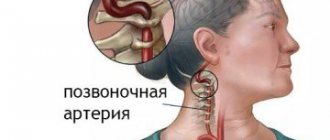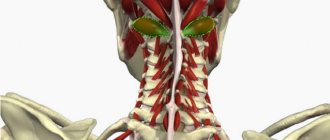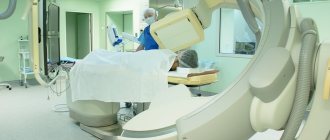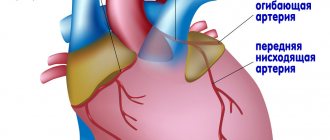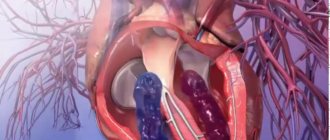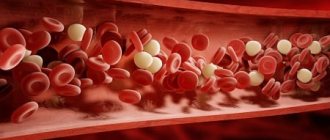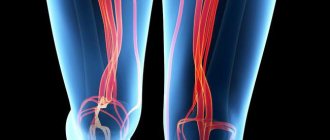What is extravasal compression of the vertebral artery?
To answer the question of what extravasal compression of the vertebral artery is, you should understand this complex term step by step.
“Compression” in medicine means “squeezing something,” in this case the vertebral artery. The vertebral arteries pass through the intervertebral foramina of the cervical vertebrae towards the spinal canal, where they supply the spinal cord. Compression of the vertebral artery is not an independent disease, but rather a consequence of the development of another pathology.
Most often, this pathology is an intervertebral hernia. It is the resulting hernia that can compress the vertebral artery, thereby disrupting the blood supply to the spinal cord. Extravasal compression of the vertebral arteries is usually localized in the area of the 4th-5th vertebrae.
Causes of the disease
As mentioned above, an intervertebral hernia can lead to extravasal compression of the right, left, or simultaneously two vertebral arteries. In turn, a hernia can occur due to developed osteochondrosis or physical overload. Other provoking factors may be:
- benign or malignant tumors in the neck;
- incorrect, abnormal structure of the spine, its curvature (congenital, acquired, traumatic).
Development mechanism
The basis of vertebral artery syndrome (abbreviated as VAS) is a narrowing (stenosis) of the lumen of this vessel as a result of compression by muscles, bone growths (osteophytes) and hernial protrusions.
Regardless of the initial factor, the effect is always identical.
Compression of the artery occurs, then its lumen narrows, the intensity of blood flow decreases.
Hence the disturbance in the nutrition of cerebral structures in the region of the occipital lobe and cerebellum, which are responsible for processing visual information and coordination of movements, respectively.
In the initial stages, with a relatively sluggish course of the disorder, everything is limited to minimal symptoms against the background of neck pain.
In more complex forms, transient ischemic attacks and full-fledged strokes of varying extent with the likelihood of death are possible.
The ideal option is to start treatment in the first 2-3 months from the onset of PA syndrome. In this case, there is a chance of a complete cure. Then the possibilities decrease in proportion to the time elapsed.
Signs of extravasal compression of the vertebral artery
Signs of extravasal compression of the right, left, or both vertebral arteries are most often temporary. This pathology manifests itself as pain. Pain appears when turning the head sharply or in the morning after waking up (since during sleep a person can remain in one position for a long time). In addition to neck pain, compression is manifested by headache (aching, throbbing), dizziness, indigestion, difficulty moving, impaired vision or hearing, and lacrimation. Also, compression of the vertebral arteries can lead to the development of neurological diseases.
Extravasal compression of the left vertebral artery
You can understand the signs of compression in more detail by the type of its localization. For example, if this pathology affects the left vertebral artery, then the symptoms may be as follows:
- frequent headache;
- dizziness, tinnitus;
- increased blood pressure;
- nausea.
With pronounced compression of the left vertebral artery, a person may even faint.
Extravasal compression of the right vertebral artery
The same symptoms may occur in patients with compression of the right vertebral artery. During exacerbations of the disease, a person may from time to time lose a sense of balance and fall, but remain conscious.
Bilateral – compression of both vertebral arteries
When both vertebral arteries are compressed, all of the above symptoms persist, but gain double strength. Moreover, all these symptoms are not specific, that is, they can accompany other diseases. This is why compression is so difficult to diagnose and prescribe treatment in a timely manner.
Stages and their symptoms
The clinical picture of vertebral artery syndrome is represented by a significant group of disorders.
They are mainly associated with the occipital lobes of the brain and the extrapyramidal system represented by the cerebellum.
- The first is responsible for the assessment and interpretation of visual data and visual information.
- The second works with the spatial aspect, allows you to coordinate movements and navigate.
In total, there are three stages of the pathological process. Each clinic will have its own.
First stage or compensation
Symptoms as such are absent altogether or are represented by a minimum of neurological disorders.
Such signs include a sluggish, regular headache, nausea, inability to spatially orientate, weakness, fatigue, decreased performance, and visual impairment.
However, for the most part, the latent phase occurs without symptoms at all, which does not allow you to react in time and consult a doctor.
Second stage - subcompensation
The clinical picture is clear enough to suspect something is wrong. The body can no longer cope with the problem using workarounds or by increasing blood flow and increasing blood pressure levels.
Symptoms include frequent severe headaches, nausea, vomiting, episodes of loss of consciousness, fatigue, visual disturbances such as photopsia (bright flashes), loss of visual fields, and others.
At this stage, a total cure is almost impossible, but there is every chance of putting the disease into remission and forgetting about it for many years or forever, if you follow the recommendations of a specialist.
Third stage - decompensation
Accompanied by generalized severe symptoms from the central nervous system. Episodes of fainting, dizziness, and pain in the occipital region become more frequent.
The full list of signs is not limited to the points mentioned above. This is just a small fraction of what is possible.
Diagnostic methods
At the first examination, the therapist
,
a neurologist
or other specialist can only suspect the presence of compression of the vertebral artery by asking the patient about all the symptoms, as well as examining him and palpating him. To clarify, confirm (or refute) the diagnosis, the following procedures may be prescribed:
- Ultrasound with Doppler. It is the Doppler study that allows us to evaluate the speed of blood flow in the arteries. On the screen, the doctor can see the lesions and identify the degree of development of the disease.
- MRI
. - CT scan
. - X-ray
.
The last three studies on the list help evaluate the structure of soft and bone tissues, identify fractures, dislocations, foci of inflammation, vascular pathologies, and tumors of various origins.
Complications of renovascular hypertension
Renovascular hypertension leads to both complications characteristic of arterial hypertension and specific problems associated with poor blood flow in the renal arteries. If blood pressure is poorly controlled, the following complications may develop:
- Aortic aneurysm
- Myocardial infarction
- Heart failure
- Chronic kidney disease
- Stroke
- Vision problems (retinopathy)
- Poor blood supply to the legs - critical ischemia.
How to treat?
Treatment of extravasal compression of both vertebral arteries is primarily to eliminate the main factor in its occurrence. That is, treatment of compression occurs in parallel and simultaneously with the treatment of intervertebral disc herniation, tumor, compression fracture, and so on.
Treatment may be medication. Patients are often prescribed painkillers and anti-inflammatory drugs to relieve pain and restore normal well-being. Drugs aimed at restoring blood flow and oxygen supply to the blood may also be prescribed. All medications should be prescribed only by your doctor. The dosage and frequency of use are very important. Self-medication can only harm and worsen the situation.
Treatment of compression can take place in other directions:
- physiotherapy;
- massage and manual therapy;
- physical therapy and special gymnastics.
When all of the above treatment methods do not produce an effect for a long time, the doctor considers the possibility and advisability of surgery. Surgeons, by making small incisions, can remove discs and tumors that are compressing the arteries. Treatment of compression should be carried out by doctors of several specializations: surgeons, therapists, neurologists, oncologists and others. You will find specialists in these and other areas at the Energo clinic. Our team consists of experienced professionals who, in their practice, have encountered various cases of compression of the vertebral artery and have positive experience in eliminating it.
Treatment
In the early stages, conservative techniques are practiced. Only when ineffective do they resort to operational measures.
Medication
Several groups of drugs are used:
- Anti-inflammatory non-steroidal origin. Ketorolac, Diclofenac, Nimesulide and others. Relieves pain and discomfort. Relieves swelling. Used for symptomatic purposes.
- Means for normalizing arterial blood flow. Pentoxifylline, Vinpocetine and others. As prescribed by a specialist.
- Medicines to restore venous activity. Troxerutin is mainly used.
- Protectors. Protect nerve tissue from destruction and oxidation. Piracetam, Mexidol, Mildronate
The duration of therapy is about 3-6 months. Then the course is reviewed and switched to maintenance medications.
Physiotherapy
Prescribed at the end of the acute period. Several techniques are practiced.
Warming is indicated for non-septic inflammatory processes after a critical phase.
Prescribed with caution. UHF and magnetic therapy are also used. This group of techniques does not work in isolation; drug support is required.
Massage
It is prescribed rarely and with great caution. Mainly for non-advanced osteochondrosis or muscle spasms and pathologies.
Against the background of hernias and anomalies, it is strictly forbidden to do it. Compression of the spinal cord and severe paralysis are possible.
An operation will be required, which does not always give a high-quality effect.
Exercises
Physical therapy is the next step. Gymnastics under the supervision of a specialized exercise therapy specialist is prescribed as part of rehabilitation, after restoration of normal blood flow.
It can also be harmful if there are complex problems such as hernias or instability.
Therefore, the issue is approached individually. The program is also developed for a specific patient or a ready-made one is adapted.
The standard set includes the following exercises for vertebral artery syndrome:
- Turns the head in a circular manner. 5 times in both directions.
- Movements left and right. 5-6 times.
- Throwing back and bending. Same quantity.
- Complete relaxation followed by sharp muscle tension. 10 times.
A technique is also practiced in which the hand is placed on the forehead, then pressed with force. The head counteracts by pressing on the palm. This exercise is performed in 4 variations (on different sides of the head).
As part of physical therapy, it is recommended to avoid excessive activity, but physical inactivity is not beneficial either. It wouldn't hurt to walk for at least an hour or two during the day.
Surgical methods
Practice last. The point is to eliminate the pathogenic factor.
This usually involves prosthetics of spinal discs and the creation of artificial supporting structures.
This is a last resort, which is why doctors are putting off such an event until the last moment.
Disease prevention
Extravasal compression of the vertebral artery is such a serious disorder that it is easier and better to prevent it than to treat it later. Treatment usually takes a long time, while prevention consists of simple things:
- active lifestyle and giving up bad habits;
- regular exercise (you don’t have to go to the gym for this, you can just do morning jogging or light exercise);
- massage aimed at improving blood flow, strengthening muscles, restoring their tone.
All of the listed preventive measures, observed in combination, will certainly give a positive result and will help to avoid not only compression of the vertebral arteries, but also other problems with the musculoskeletal system, nervous system, heart and vascular system, and so on.
#!NevrologKONEC!#
Preventive measures aimed at preventing the development of pathology
If the patient is not registered with a dispensary, he should undergo an annual medical examination. It is also necessary to promptly treat pathological conditions that can lead to the development of SPA, and do not forget to engage in sports and physical therapy aimed at relieving tone and strengthening the muscle corset. If there is such an opportunity, then it is worth periodically attending SHVZ massage sessions.
You should not ignore preventive measures after surgery. They will prevent relapses of pathology and improve general condition.
It is also worth normalizing your own diet. It must be balanced and correct, as it plays an important role in the prevention of almost all pathologies. A patient suffering from this disease should adhere to any diet designed to combat cardiovascular pathologies.
